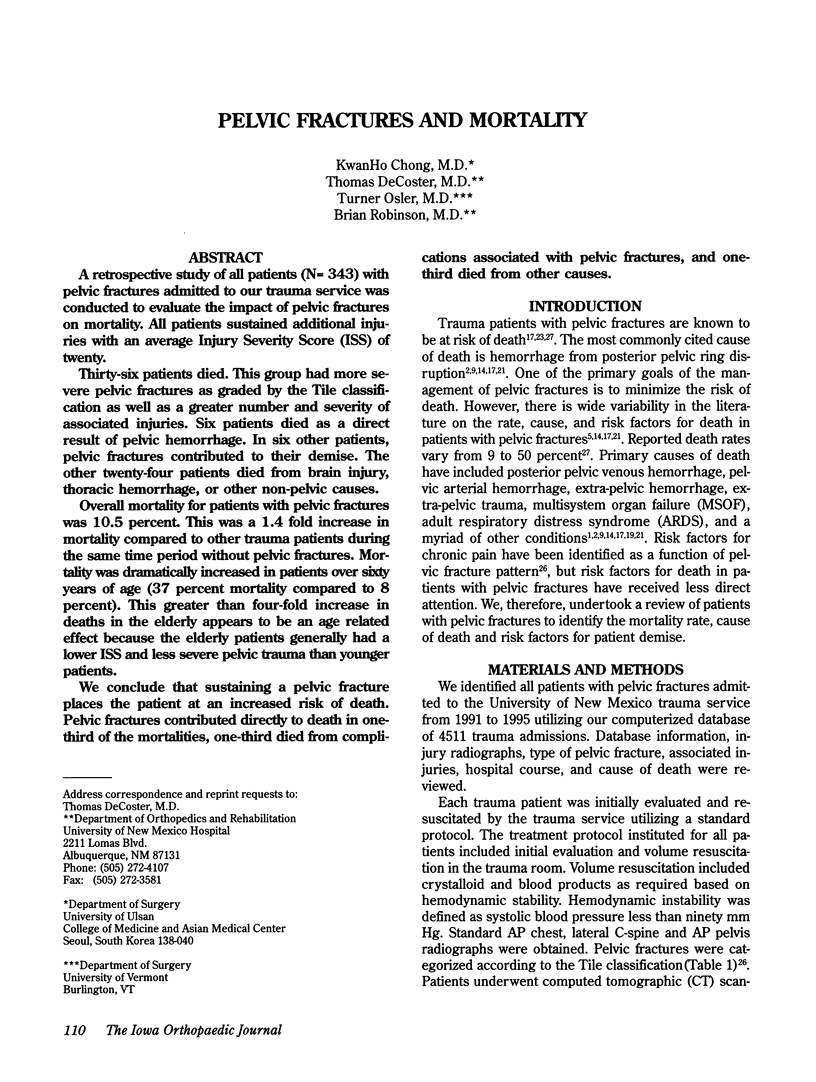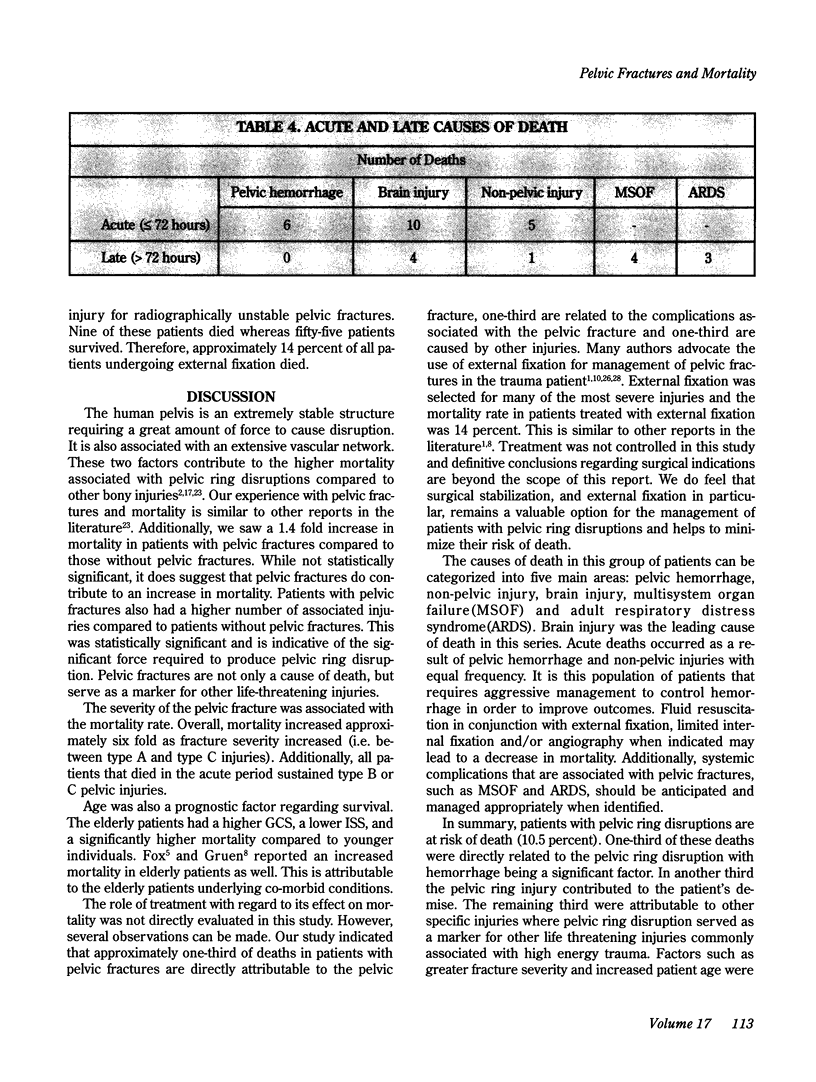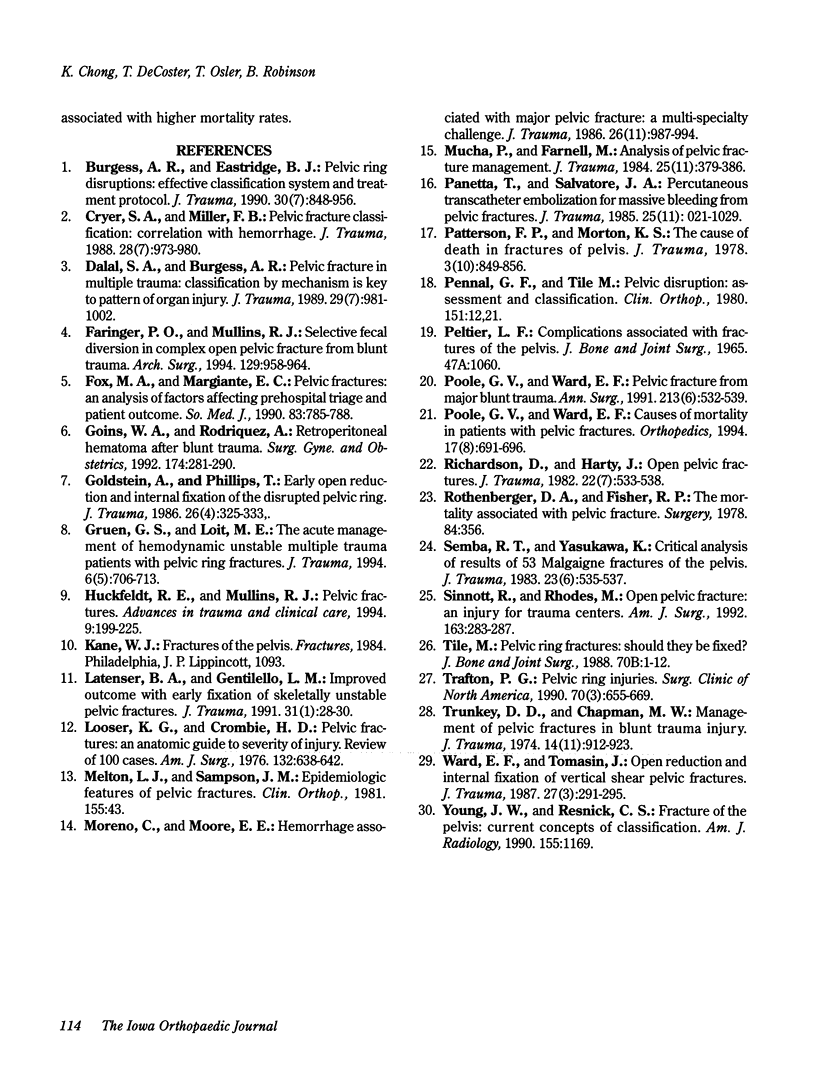Abstract
A retrospective study of all patients (N = 343) with pelvic fractures admitted to our trauma service was conducted to evaluate the impact of pelvic fractures on mortality. All patients sustained additional injuries with an average Injury Severity Score (ISS) of twenty. Thirty-six patients died. This group had more severe pelvic fractures as graded by the Tile classification as well as a greater number and severity of associated injuries. Six patients died as a direct result of pelvic hemorrhage. In six other patients, pelvic fractures contributed to their demise. The other twenty-four patients died from brain injury, thoracic hemorrhage, or other non-pelvic causes. Overall mortality for patients with pelvic fractures was 10.5 percent This was a 1.4 fold increase in mortality compared to other trauma patients during the same time period without pelvic fractures. Mortality was dramatically increased in patients over sixty years of age (37 percent mortality compared to 8 percent). This greater than four-fold increase in deaths in the elderly appears to be an age related effect because the elderly patients generally had a lower ISS and less severe pelvic trauma than younger patients. We conclude that sustaining a pelvic fracture places the patient at an increased risk of death. Pelvic fractures contributed directly to death in one-third of the mortalities, one-third died from complications associated with pelvic fractures, and one-third died from other causes.
Full text
PDF




Selected References
These references are in PubMed. This may not be the complete list of references from this article.
- Burgess A. R., Eastridge B. J., Young J. W., Ellison T. S., Ellison P. S., Jr, Poka A., Bathon G. H., Brumback R. J. Pelvic ring disruptions: effective classification system and treatment protocols. J Trauma. 1990 Jul;30(7):848–856. [PubMed] [Google Scholar]
- Cryer H. M., Miller F. B., Evers B. M., Rouben L. R., Seligson D. L. Pelvic fracture classification: correlation with hemorrhage. J Trauma. 1988 Jul;28(7):973–980. [PubMed] [Google Scholar]
- Dalal S. A., Burgess A. R., Siegel J. H., Young J. W., Brumback R. J., Poka A., Dunham C. M., Gens D., Bathon H. Pelvic fracture in multiple trauma: classification by mechanism is key to pattern of organ injury, resuscitative requirements, and outcome. J Trauma. 1989 Jul;29(7):981–1002. [PubMed] [Google Scholar]
- Faringer P. D., Mullins R. J., Feliciano P. D., Duwelius P. J., Trunkey D. D. Selective fecal diversion in complex open pelvic fractures from blunt trauma. Arch Surg. 1994 Sep;129(9):958–964. doi: 10.1001/archsurg.1994.01420330072014. [DOI] [PubMed] [Google Scholar]
- Fox M. A., Mangiante E. C., Fabian T. C., Voeller G. R., Kudsk K. A. Pelvic fractures: an analysis of factors affecting prehospital triage and patient outcome. South Med J. 1990 Jul;83(7):785–788. doi: 10.1097/00007611-199007000-00017. [DOI] [PubMed] [Google Scholar]
- Goins W. A., Rodriguez A., Lewis J., Brathwaite C. E., James E. Retroperitoneal hematoma after blunt trauma. Surg Gynecol Obstet. 1992 Apr;174(4):281–290. [PubMed] [Google Scholar]
- Goldstein A., Phillips T., Sclafani S. J., Scalea T., Duncan A., Goldstein J., Panetta T., Shaftan G. Early open reduction and internal fixation of the disrupted pelvic ring. J Trauma. 1986 Apr;26(4):325–333. doi: 10.1097/00005373-198604000-00004. [DOI] [PubMed] [Google Scholar]
- Gruen G. S., Leit M. E., Gruen R. J., Peitzman A. B. The acute management of hemodynamically unstable multiple trauma patients with pelvic ring fractures. J Trauma. 1994 May;36(5):706–713. doi: 10.1097/00005373-199405000-00019. [DOI] [PubMed] [Google Scholar]
- Latenser B. A., Gentilello L. M., Tarver A. A., Thalgott J. S., Batdorf J. W. Improved outcome with early fixation of skeletally unstable pelvic fractures. J Trauma. 1991 Jan;31(1):28–31. doi: 10.1097/00005373-199101000-00006. [DOI] [PubMed] [Google Scholar]
- Looser K. G., Crombie H. D., Jr Pelvic fractures: an anatomic guide to severity of injury. Review of 100 cases. Am J Surg. 1976 Nov;132(5):638–642. doi: 10.1016/0002-9610(76)90361-5. [DOI] [PubMed] [Google Scholar]
- Moreno C., Moore E. E., Rosenberger A., Cleveland H. C. Hemorrhage associated with major pelvic fracture: a multispecialty challenge. J Trauma. 1986 Nov;26(11):987–994. doi: 10.1097/00005373-198611000-00005. [DOI] [PubMed] [Google Scholar]
- Mucha P., Jr, Farnell M. B. Analysis of pelvic fracture management. J Trauma. 1984 May;24(5):379–386. doi: 10.1097/00005373-198405000-00002. [DOI] [PubMed] [Google Scholar]
- PELTIER L. F. COMPLICATIONS ASSOCIATED WITH FRACTURES OF THE PELVIS. J Bone Joint Surg Am. 1965 Jul;47:1060–1069. [PubMed] [Google Scholar]
- Panetta T., Sclafani S. J., Goldstein A. S., Phillips T. F., Shaftan G. W. Percutaneous transcatheter embolization for massive bleeding from pelvic fractures. J Trauma. 1985 Nov;25(11):1021–1029. [PubMed] [Google Scholar]
- Pennal G. F., Tile M., Waddell J. P., Garside H. Pelvic disruption: assessment and classification. Clin Orthop Relat Res. 1980 Sep;(151):12–21. [PubMed] [Google Scholar]
- Poole G. V., Ward E. F. Causes of mortality in patients with pelvic fractures. Orthopedics. 1994 Aug;17(8):691–696. doi: 10.3928/0147-7447-19940801-07. [DOI] [PubMed] [Google Scholar]
- Poole G. V., Ward E. F., Muakkassa F. F., Hsu H. S., Griswold J. A., Rhodes R. S. Pelvic fracture from major blunt trauma. Outcome is determined by associated injuries. Ann Surg. 1991 Jun;213(6):532–539. doi: 10.1097/00000658-199106000-00002. [DOI] [PMC free article] [PubMed] [Google Scholar]
- Richardson J. D., Harty J., Amin M., Flint L. M. Open pelvic fractures. J Trauma. 1982 Jul;22(7):533–538. doi: 10.1097/00005373-198207000-00002. [DOI] [PubMed] [Google Scholar]
- Rothenberger D. A., Fischer R. P., Strate R. G., Velasco R., Perry J. F., Jr The mortality associated with pelvic fractures. Surgery. 1978 Sep;84(3):356–361. [PubMed] [Google Scholar]
- Semba R. T., Yasukawa K., Gustilo R. B. Critical analysis of results of 53 Malgaigne fractures of the pelvis. J Trauma. 1983 Jun;23(6):535–537. doi: 10.1097/00005373-198306000-00016. [DOI] [PubMed] [Google Scholar]
- Sinnott R., Rhodes M., Brader A. Open pelvic fracture: an injury for trauma centers. Am J Surg. 1992 Mar;163(3):283–287. doi: 10.1016/0002-9610(92)90003-a. [DOI] [PubMed] [Google Scholar]
- Tile M. Pelvic ring fractures: should they be fixed? J Bone Joint Surg Br. 1988 Jan;70(1):1–12. doi: 10.1302/0301-620X.70B1.3276697. [DOI] [PubMed] [Google Scholar]
- Trafton P. G. Pelvic ring injuries. Surg Clin North Am. 1990 Jun;70(3):655–669. doi: 10.1016/s0039-6109(16)45135-2. [DOI] [PubMed] [Google Scholar]
- Trunkey D. D., Chapman M. W., Lim R. C., Jr, Dunphy J. E. Management of pelvic fractures in blunt trauma injury. J Trauma. 1974 Nov;14(11):912–923. doi: 10.1097/00005373-197411000-00002. [DOI] [PubMed] [Google Scholar]
- Ward E. F., Tomasin J., Vander Griend R. A. Open reduction and internal fixation of vertical shear pelvic fractures. J Trauma. 1987 Mar;27(3):291–295. doi: 10.1097/00005373-198703000-00011. [DOI] [PubMed] [Google Scholar]
- Young J. W., Resnik C. S. Fracture of the pelvis: current concepts of classification. AJR Am J Roentgenol. 1990 Dec;155(6):1169–1175. doi: 10.2214/ajr.155.6.2122661. [DOI] [PubMed] [Google Scholar]


